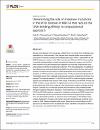Determining the role of missense mutations in the POU domain of HNF1A that reduce the DNA-binding affinity: A computational approach
| المؤلف | P., Sneha |
| المؤلف | D., Thirumal Kumar |
| المؤلف | C., George Priya Doss |
| المؤلف | R., Siva |
| المؤلف | Zayed, Hatem |
| تاريخ الإتاحة | 2017-05-10T05:22:22Z |
| تاريخ النشر | 2017-04-14 |
| اسم المنشور | Plos One |
| المعرّف | http://dx.doi.org/10.1371/journal.pone.0174953 |
| الاقتباس | P. S, D. TK, C. GPD, R. S, Zayed H (2017) Determining the role of missense mutations in the POU domain of HNF1A that reduce the DNA-binding affinity: A computational approach. PLoS ONE 12(4): e0174953. |
| الملخص | Maturity-onset diabetes of the young type 3 (MODY3) is a non-ketotic form of diabetes associated with poor insulin secretion. Over the past years, several studies have reported the association of missense mutations in the Hepatocyte Nuclear Factor 1 Alpha (HNF1A) with MODY3. Missense mutations in the POU homeodomain (POUH) of HNF1A hinder binding to the DNA, thereby leading to a dysfunctional protein. Missense mutations of the HNF1A were retrieved from public databases and subjected to a three-step computational mutational analysis to identify the underlying mechanism. First, the pathogenicity and stability of the mutations were analyzed to determine whether they alter protein structure and function. Second, the sequence conservation and DNA-binding sites of the mutant positions were assessed; as HNF1A protein is a transcription factor. Finally, the biochemical properties of the biological system were validated using molecular dynamic simulations in Gromacs 4.6.3 package. Two arginine residues (131 and 203) in the HNF1A protein are highly conserved residues and contribute to the function of the protein. Furthermore, the R131W, R131Q, and R203C mutations were predicted to be highly deleterious by in silico tools and showed lower binding affinity with DNA when compared to the native protein using the molecular docking analysis. Triplicate runs of molecular dynamic (MD) simulations (50ns) revealed smaller changes in patterns of deviation, fluctuation, and compactness, in complexes containing the R131Q and R131W mutations, compared to complexes containing the R203C mutant complex. We observed reduction in the number of intermolecular hydrogen bonds, compactness, and electrostatic potential, as well as the loss of salt bridges, in the R203C mutant complex. Substitution of arginine with cysteine at position 203 decreases the affinity of the protein for DNA, thereby destabilizing the protein. Based on our current findings, the MD approach is an important tool for elucidating the impact and affinity of mutations in DNA-protein interactions and understanding their function. |
| راعي المشروع | Qatar University grant QUUG-CAS-DHS-14/15-3. |
| اللغة | en |
| الناشر | Plos One |
| الموضوع | DNA-binding affinity computational approach HNF1A MODY 3 Arginine |
| النوع | Article |
| رقم العدد | 4 |
| رقم المجلد | 12 |
| ESSN | 1932-6203 |
الملفات في هذه التسجيلة
هذه التسجيلة تظهر في المجموعات التالية
-
العلوم الحيوية الطبية [652 items ]


